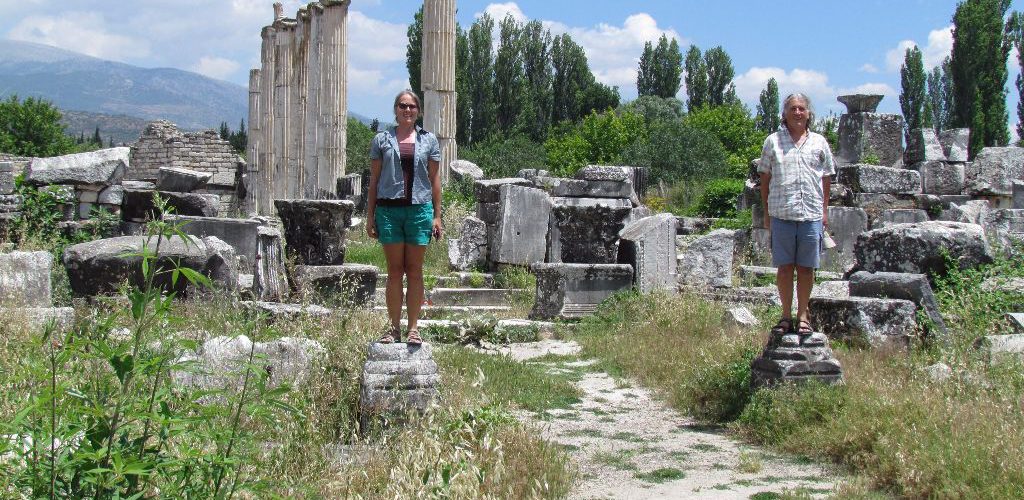Pamukkale and Heirapolis
June: Our second inland trip took us first to Pamukkale to visit the travertines and Roman ruins of Heirapolis.
The drive from Marmaris to Pamukkale took about 3 hours, passing through some lovely countryside. Most of the roads were quiet and well made, although there were sections that were still being made! There we had to drive along the dirt with lots of pot holes ready to catch the unwary and dust flying everywhere.
We arrived at our hotel (the Melrose House Hotel) early afternoon. The room was fantastic – very spacious and I’ve never slept in a round bed before! No bath, but the shower had a rainforest head that made it very difficult to get out of.
Our first view of the travertine terraces was from the lower gate; a vast swath of white glistening in the bright sun with an ant-like line of people walking up one side. The water flowing out of springs at the top contains a calcium carbonate mineral which is left behind as the water runs down. Over millennia of years knobbly stalactites have grown together to create snowy white cliffs with milky blue pools below them. Up on top sits the ruins of a Greco-Roman spa town where the hot springs turned the city into a healing centre since the second century BC.
Entry was 35TL and we had to remove our shoes to walk on the white stuff. It was surprisingly hard underfoot and ripples and ridges had formed where the water had flowed over it. We would be having a natural foot exfoliation as we walked up the terrace.
But where was the water? A sad trickle rolled down towards us, but the bulk of the water was thundering down a gully to the side of the track. Upwards we went in hope of finding some pools.
It didn’t take long to find them. At the side of the narrow track, the water had gathered in man made pools, the calcium having dribbled over the concrete structures to make them look a little more natural. We went in for a paddle, the soft, beige mud oozing up between our toes. “Like walking in builders plaster”, said Colin. It was pleasantly warm too. The higher we got, the fuller the pools became and we could see the water trickling over the cliffs from higher up. All the run off eventually ended up in the side gully which was like a raging torrent.
Shoes back on at the top, we made our way to the furthest point of the ruins at the North Gate. Along the way we passed dried out travertines, going brown in the sun. It looked like the water output could be turned on and off with pipes and valves set under a wooden boardwalk. We wondered why there was no water – was it just a dry time of year or is the water being siphoned off elsewhere?
The ruins of the Frontinius gate and baths were vast, they would have been an imposing sight in their day. Beyond them, tomb upon tomb of the necropolis stretched out into the distance. Walking back into the site we visited the remains of grand temples, a huge theatre and a church to St. Philip, who apparently was buried in the middle of the building.
Before making our way back down, we walked along the boardwalks above where the water was flowing under apricot trees loaded with fruit. Steam was rising off the water and the blueness of it matched the sky. There is a pool you can swim in too, but we didn’t go in.
It was after 3pm when we arrived; there were a couple of bottlenecks on the path but not over crowded. The majority of the visitors must have been bussed in as in the evening the village was deserted. Restaurants were empty with owners working hard to get us to visit, even offering free glasses or wine. Well that worked for us and we enjoyed a filling meal of stuffed aubergine, falafal and kebab. We were also visited by the strangest looking bug I’ve ever seen. It definitely had a liking for us, coming back time after time after being ‘persuaded’ to go away.
Aphrodisias
The traditional breakfast the next day was tasty and filling. Lots of warm bread, preserved cherries, jams, honey, olives, fruit, salad, cake and cheese and my favourite – a warm bowl of cooked peppers, tomatoes, egg and cheese. We were well fortified for more ruin wandering.
After a drive over a hill through beautiful countryside, we parked up and rode in a carriage pulled by a tractor to the site of the ruins of Aphrodisias, a city dedicated to the Greek goddess of love, Aphrodite. Not many people visit, which is a shame as it’s a huge site with some of the best ruins we’ve seen; it must once have been a beautiful city. Monumental entrance arches have been reconstructed and there is a stadium, with nature taking over where the ancients once competed. A theatre, baths, bouleuterion (council house) and temples have been uncovered and a huge agora is currently being worked on. Signs in English provided detailed information about each location. Wandering the site was very pleasant in the hot sun with plenty of leafy shade from the trees.
Inside the museum, a long hall is lined down each side with vast carved stone reliefs depicting Greek myths, gods, goddesses and Roman figures that once adorned the Sebastion, a Temple of Augustus. Definitely worthy of a visit.
































